Cityscape of Harbin in China's Heilongjiang
新華網(wǎng)
Editor: huaxia
2025-06-26 21:13:06
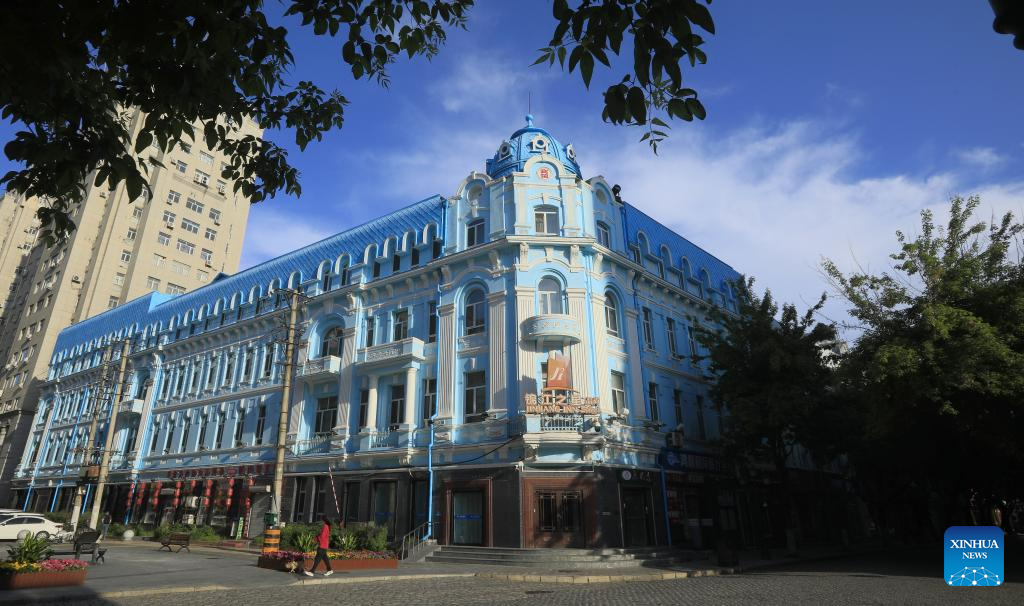
This photo taken on June 11, 2025 shows a historical building at the Central Street in Harbin, northeast China's Heilongjiang Province.
Harbin is often described by its residents as a city that emerged in tandem with the railway. Iconic buildings such as the St. Sophia Cathedral stand as evidence of European migration, trade and culture that dated back to the late 19th and early 20th centuries after the construction of the Chinese Eastern Railway in 1898. Records show Harbin was once home to people from over 30 countries.
The city, with over 9 million residents, now boasts 16 different architectural styles -- Byzantine, neo-classical, art deco, baroque -- and its number of historical buildings accounts for over 1,000.
Harbin, like many Chinese metropolises, has seen significant cultural development in recent years, which reflects the city's growth and increasing global outreach. Such development has further shaped the city's identity and enriched the lives of residents. (Photo by Zhang Shu/Xinhua)

People visit the building of a pharmaceutical company in Harbin, northeast China's Heilongjiang Province, Jan. 17, 2024.
Harbin is often described by its residents as a city that emerged in tandem with the railway. Iconic buildings such as the St. Sophia Cathedral stand as evidence of European migration, trade and culture that dated back to the late 19th and early 20th centuries after the construction of the Chinese Eastern Railway in 1898. Records show Harbin was once home to people from over 30 countries.
The city, with over 9 million residents, now boasts 16 different architectural styles -- Byzantine, neo-classical, art deco, baroque -- and its number of historical buildings accounts for over 1,000.
Harbin, like many Chinese metropolises, has seen significant cultural development in recent years, which reflects the city's growth and increasing global outreach. Such development has further shaped the city's identity and enriched the lives of residents. (Xinhua/Xie Jianfei)
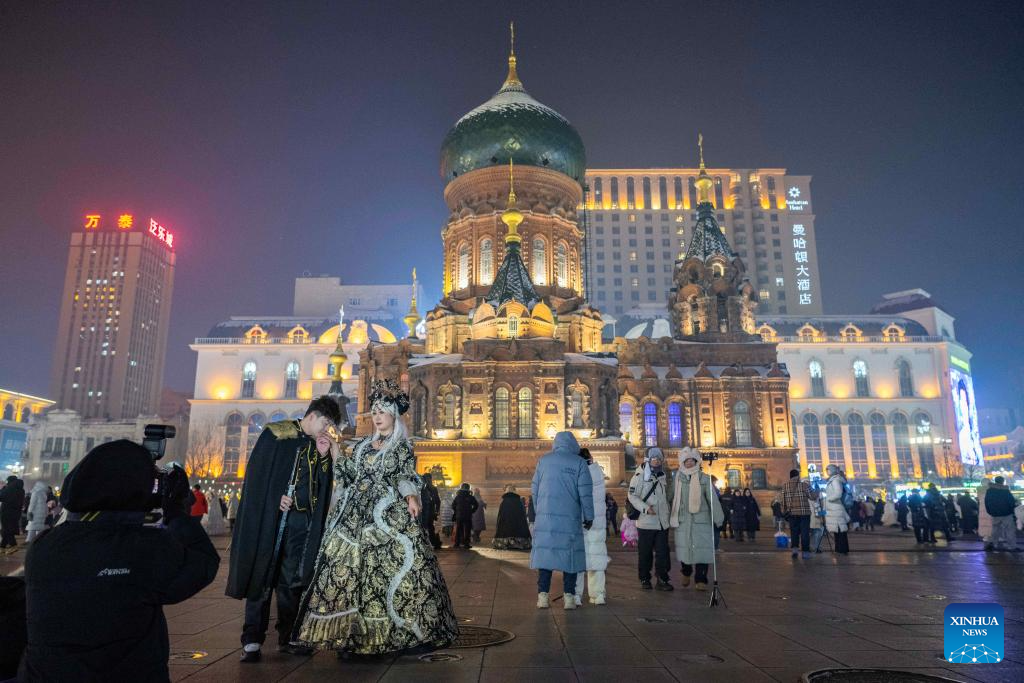
People visit the St. Sophia Cathedral in Harbin, capital of northeast China's Heilongjiang Province, Jan. 23, 2025.
Harbin is often described by its residents as a city that emerged in tandem with the railway. Iconic buildings such as the St. Sophia Cathedral stand as evidence of European migration, trade and culture that dated back to the late 19th and early 20th centuries after the construction of the Chinese Eastern Railway in 1898. Records show Harbin was once home to people from over 30 countries.
The city, with over 9 million residents, now boasts 16 different architectural styles -- Byzantine, neo-classical, art deco, baroque -- and its number of historical buildings accounts for over 1,000.
Harbin, like many Chinese metropolises, has seen significant cultural development in recent years, which reflects the city's growth and increasing global outreach. Such development has further shaped the city's identity and enriched the lives of residents. (Xinhua/Xie Jianfei)
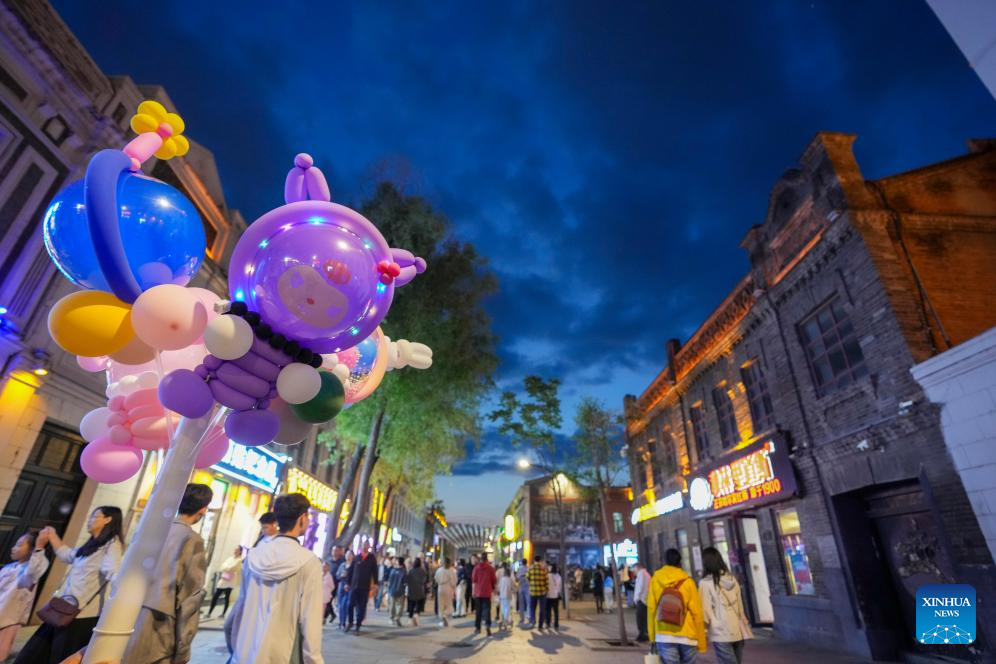
People visit a historical and cultural district in Harbin, northeast China's Heilongjiang Province, June 7, 2025.
Harbin is often described by its residents as a city that emerged in tandem with the railway. Iconic buildings such as the St. Sophia Cathedral stand as evidence of European migration, trade and culture that dated back to the late 19th and early 20th centuries after the construction of the Chinese Eastern Railway in 1898. Records show Harbin was once home to people from over 30 countries.
The city, with over 9 million residents, now boasts 16 different architectural styles -- Byzantine, neo-classical, art deco, baroque -- and its number of historical buildings accounts for over 1,000.
Harbin, like many Chinese metropolises, has seen significant cultural development in recent years, which reflects the city's growth and increasing global outreach. Such development has further shaped the city's identity and enriched the lives of residents. (Xinhua/Wang Jianwei)
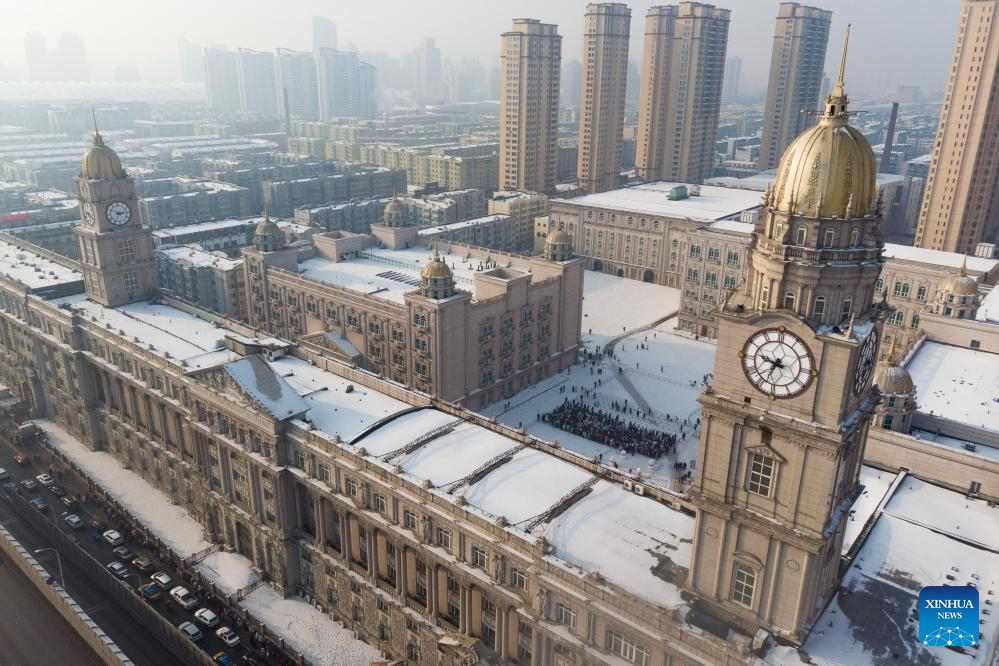
An aerial drone photo taken on Jan. 17, 2024 shows the buildings of a pharmaceutical company in Harbin, northeast China's Heilongjiang Province.
Harbin is often described by its residents as a city that emerged in tandem with the railway. Iconic buildings such as the St. Sophia Cathedral stand as evidence of European migration, trade and culture that dated back to the late 19th and early 20th centuries after the construction of the Chinese Eastern Railway in 1898. Records show Harbin was once home to people from over 30 countries.
The city, with over 9 million residents, now boasts 16 different architectural styles -- Byzantine, neo-classical, art deco, baroque -- and its number of historical buildings accounts for over 1,000.
Harbin, like many Chinese metropolises, has seen significant cultural development in recent years, which reflects the city's growth and increasing global outreach. Such development has further shaped the city's identity and enriched the lives of residents. (Xinhua/Xie Jianfei)
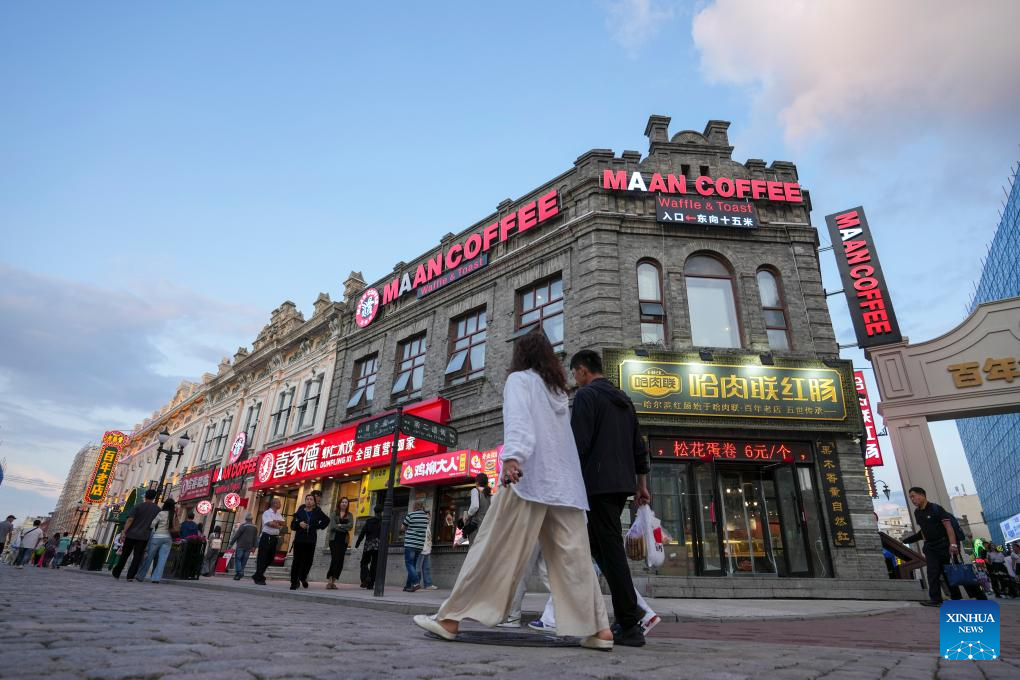
People visit a historical and cultural district in Harbin, northeast China's Heilongjiang Province, June 7, 2025.
Harbin is often described by its residents as a city that emerged in tandem with the railway. Iconic buildings such as the St. Sophia Cathedral stand as evidence of European migration, trade and culture that dated back to the late 19th and early 20th centuries after the construction of the Chinese Eastern Railway in 1898. Records show Harbin was once home to people from over 30 countries.
The city, with over 9 million residents, now boasts 16 different architectural styles -- Byzantine, neo-classical, art deco, baroque -- and its number of historical buildings accounts for over 1,000.
Harbin, like many Chinese metropolises, has seen significant cultural development in recent years, which reflects the city's growth and increasing global outreach. Such development has further shaped the city's identity and enriched the lives of residents. (Xinhua/Wang Jianwei)
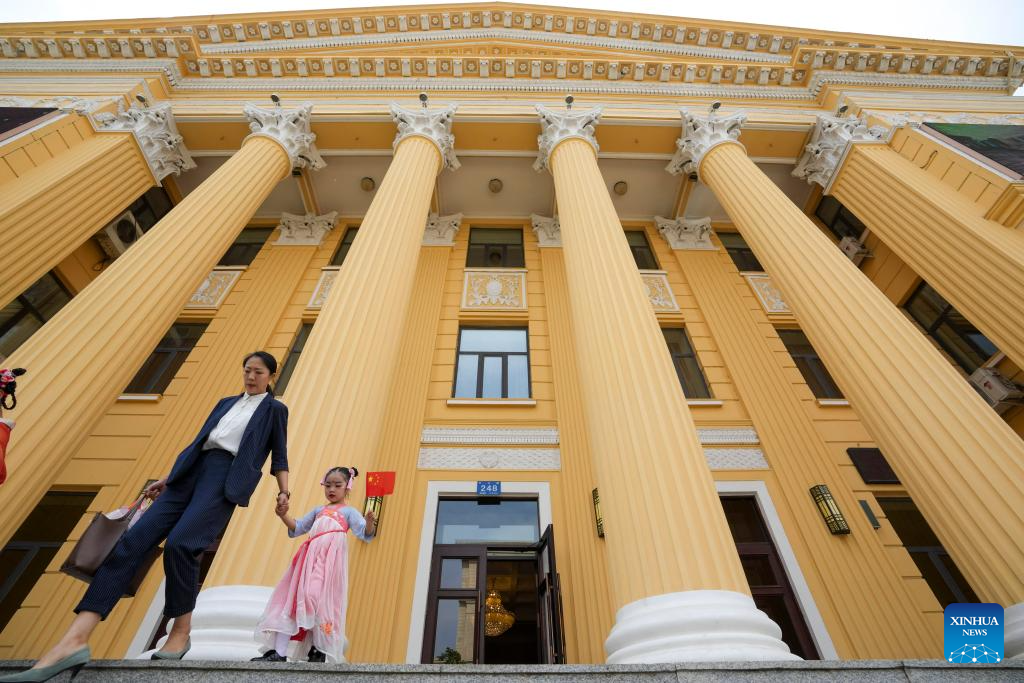
People leave a historical building in Harbin, northeast China's Heilongjiang Province, June 8, 2025.
Harbin is often described by its residents as a city that emerged in tandem with the railway. Iconic buildings such as the St. Sophia Cathedral stand as evidence of European migration, trade and culture that dated back to the late 19th and early 20th centuries after the construction of the Chinese Eastern Railway in 1898. Records show Harbin was once home to people from over 30 countries.
The city, with over 9 million residents, now boasts 16 different architectural styles -- Byzantine, neo-classical, art deco, baroque -- and its number of historical buildings accounts for over 1,000.
Harbin, like many Chinese metropolises, has seen significant cultural development in recent years, which reflects the city's growth and increasing global outreach. Such development has further shaped the city's identity and enriched the lives of residents. (Xinhua/Wang Jianwei)
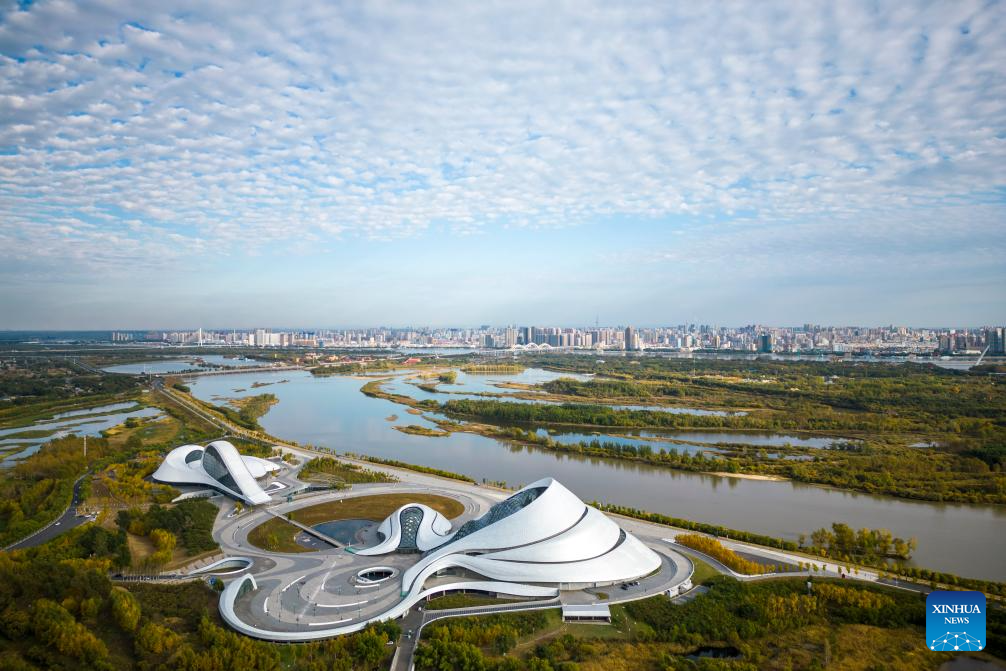
An aerial drone photo taken on Sept. 26, 2022 shows a view of Harbin Grand Theatre in Harbin, northeast China's Heilongjiang Province.
Harbin is often described by its residents as a city that emerged in tandem with the railway. Iconic buildings such as the St. Sophia Cathedral stand as evidence of European migration, trade and culture that dated back to the late 19th and early 20th centuries after the construction of the Chinese Eastern Railway in 1898. Records show Harbin was once home to people from over 30 countries.
The city, with over 9 million residents, now boasts 16 different architectural styles -- Byzantine, neo-classical, art deco, baroque -- and its number of historical buildings accounts for over 1,000.
Harbin, like many Chinese metropolises, has seen significant cultural development in recent years, which reflects the city's growth and increasing global outreach. Such development has further shaped the city's identity and enriched the lives of residents. (Xinhua/Zhang Tao)
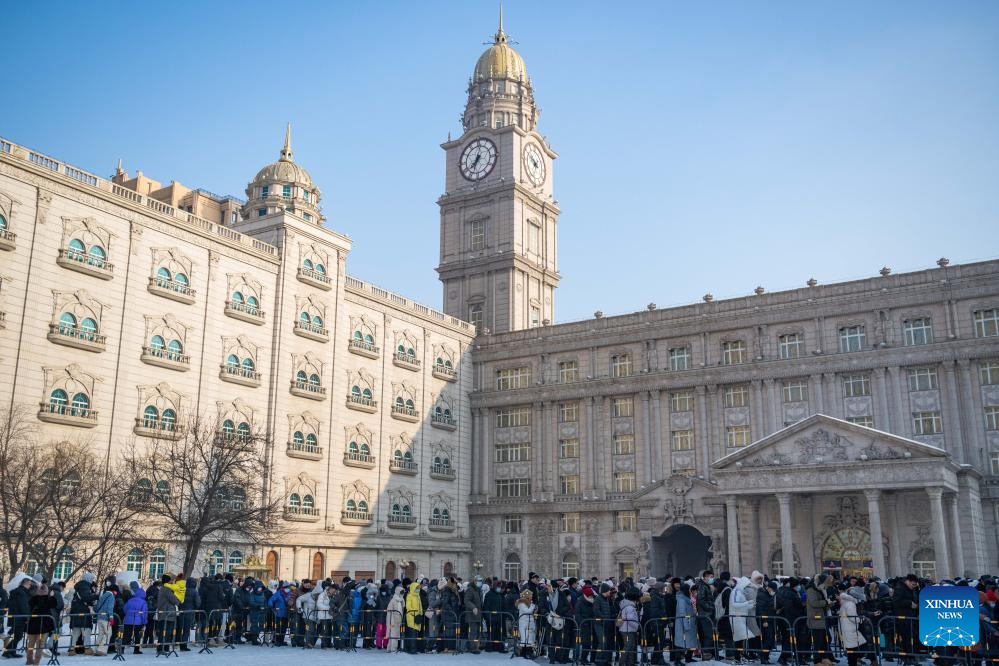
People wait to visit the building of a pharmaceutical company in Harbin, northeast China's Heilongjiang Province, Jan. 17, 2024.
Harbin is often described by its residents as a city that emerged in tandem with the railway. Iconic buildings such as the St. Sophia Cathedral stand as evidence of European migration, trade and culture that dated back to the late 19th and early 20th centuries after the construction of the Chinese Eastern Railway in 1898. Records show Harbin was once home to people from over 30 countries.
The city, with over 9 million residents, now boasts 16 different architectural styles -- Byzantine, neo-classical, art deco, baroque -- and its number of historical buildings accounts for over 1,000.
Harbin, like many Chinese metropolises, has seen significant cultural development in recent years, which reflects the city's growth and increasing global outreach. Such development has further shaped the city's identity and enriched the lives of residents. (Xinhua/Xie Jianfei)
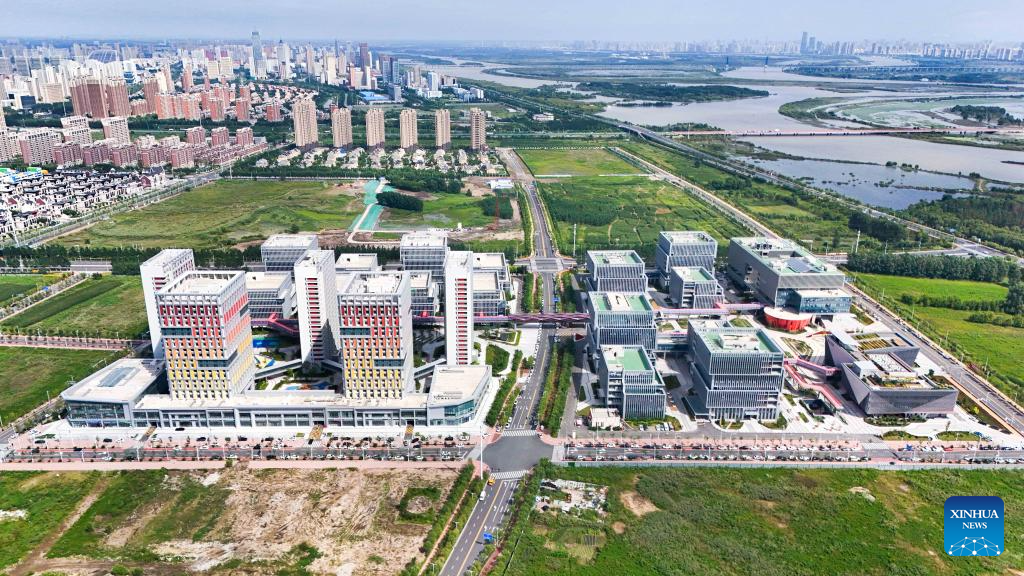
An aerial drone photo taken on Aug. 20, 2024 shows a view of the Shenzhen-Harbin industrial park in Harbin New Area in Harbin, northeast China's Heilongjiang Province.
Harbin is often described by its residents as a city that emerged in tandem with the railway. Iconic buildings such as the St. Sophia Cathedral stand as evidence of European migration, trade and culture that dated back to the late 19th and early 20th centuries after the construction of the Chinese Eastern Railway in 1898. Records show Harbin was once home to people from over 30 countries.
The city, with over 9 million residents, now boasts 16 different architectural styles -- Byzantine, neo-classical, art deco, baroque -- and its number of historical buildings accounts for over 1,000.
Harbin, like many Chinese metropolises, has seen significant cultural development in recent years, which reflects the city's growth and increasing global outreach. Such development has further shaped the city's identity and enriched the lives of residents. (Xinhua/Wang Song)

An aerial drone photo taken on Aug. 20, 2024 shows a view of Harbin Grand Theatre in Harbin, northeast China's Heilongjiang Province.
Harbin is often described by its residents as a city that emerged in tandem with the railway. Iconic buildings such as the St. Sophia Cathedral stand as evidence of European migration, trade and culture that dated back to the late 19th and early 20th centuries after the construction of the Chinese Eastern Railway in 1898. Records show Harbin was once home to people from over 30 countries.
The city, with over 9 million residents, now boasts 16 different architectural styles -- Byzantine, neo-classical, art deco, baroque -- and its number of historical buildings accounts for over 1,000.
Harbin, like many Chinese metropolises, has seen significant cultural development in recent years, which reflects the city's growth and increasing global outreach. Such development has further shaped the city's identity and enriched the lives of residents. (Xinhua/Wang Song)
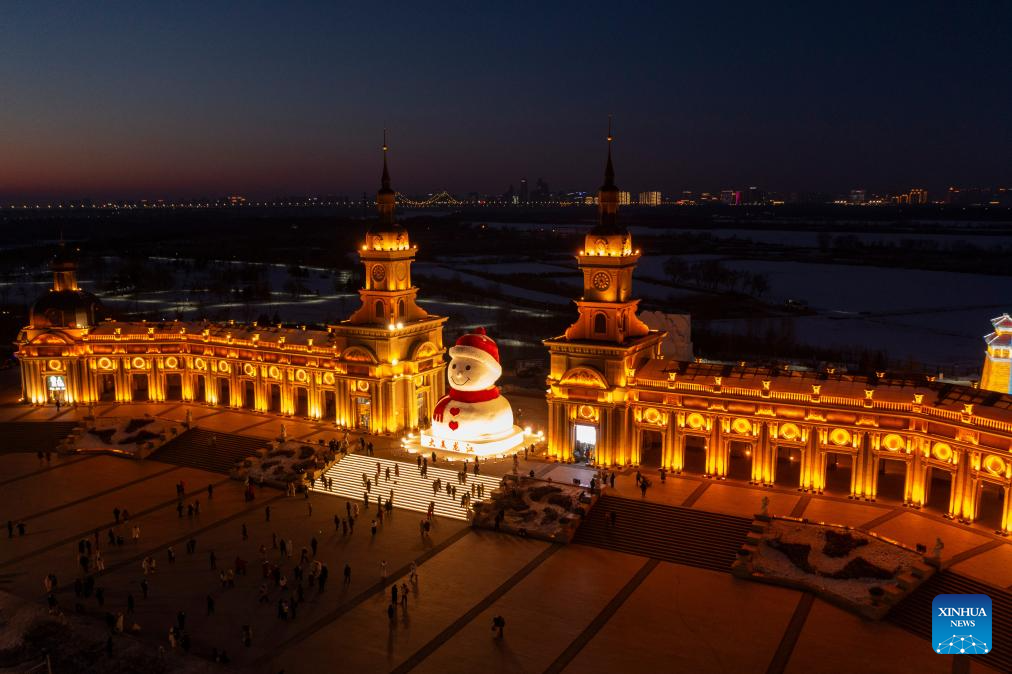
An aerial drone photo taken on Jan. 3, 2025 shows people having fun around a giant snowman near the Qunli music park in Harbin, northeast China's Heilongjiang Province.
Harbin is often described by its residents as a city that emerged in tandem with the railway. Iconic buildings such as the St. Sophia Cathedral stand as evidence of European migration, trade and culture that dated back to the late 19th and early 20th centuries after the construction of the Chinese Eastern Railway in 1898. Records show Harbin was once home to people from over 30 countries.
The city, with over 9 million residents, now boasts 16 different architectural styles -- Byzantine, neo-classical, art deco, baroque -- and its number of historical buildings accounts for over 1,000.
Harbin, like many Chinese metropolises, has seen significant cultural development in recent years, which reflects the city's growth and increasing global outreach. Such development has further shaped the city's identity and enriched the lives of residents. (Xinhua/Xie Jianfei)
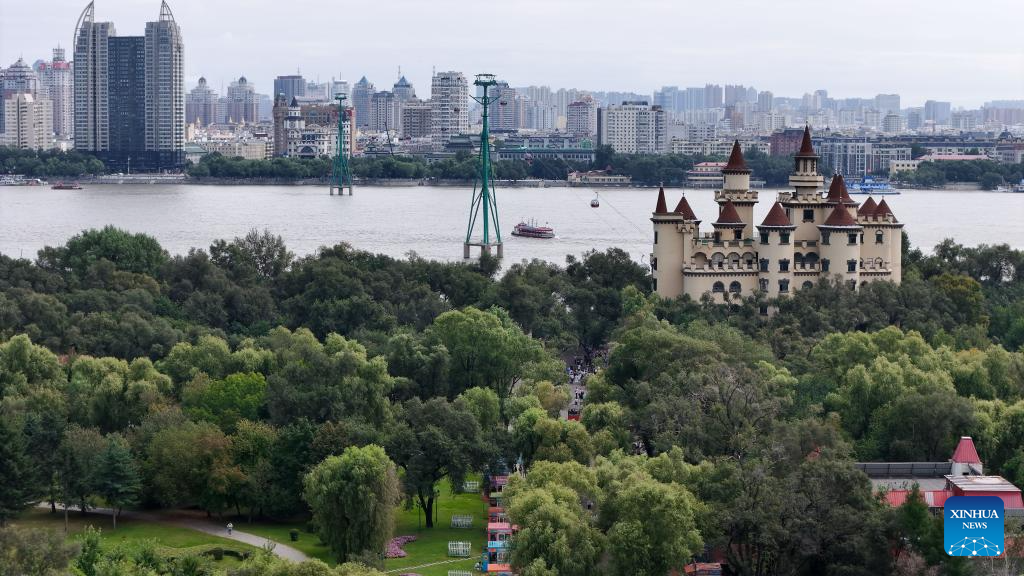
An aerial drone photo taken on Aug. 20, 2024 shows a view along the Songhua River in Harbin, northeast China's Heilongjiang Province.
Harbin is often described by its residents as a city that emerged in tandem with the railway. Iconic buildings such as the St. Sophia Cathedral stand as evidence of European migration, trade and culture that dated back to the late 19th and early 20th centuries after the construction of the Chinese Eastern Railway in 1898. Records show Harbin was once home to people from over 30 countries.
The city, with over 9 million residents, now boasts 16 different architectural styles -- Byzantine, neo-classical, art deco, baroque -- and its number of historical buildings accounts for over 1,000.
Harbin, like many Chinese metropolises, has seen significant cultural development in recent years, which reflects the city's growth and increasing global outreach. Such development has further shaped the city's identity and enriched the lives of residents. (Xinhua/Wang Song)
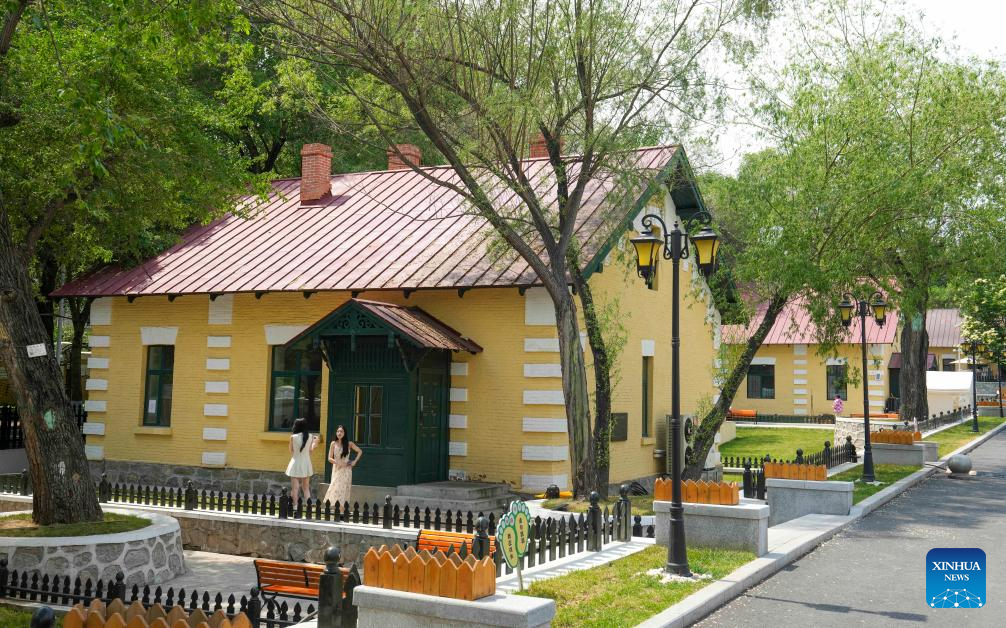
People visit at a historical and cultural district in Harbin, northeast China's Heilongjiang Province, June 8, 2025.
Harbin is often described by its residents as a city that emerged in tandem with the railway. Iconic buildings such as the St. Sophia Cathedral stand as evidence of European migration, trade and culture that dated back to the late 19th and early 20th centuries after the construction of the Chinese Eastern Railway in 1898. Records show Harbin was once home to people from over 30 countries.
The city, with over 9 million residents, now boasts 16 different architectural styles -- Byzantine, neo-classical, art deco, baroque -- and its number of historical buildings accounts for over 1,000.
Harbin, like many Chinese metropolises, has seen significant cultural development in recent years, which reflects the city's growth and increasing global outreach. Such development has further shaped the city's identity and enriched the lives of residents. (Xinhua/Wang Jianwei)
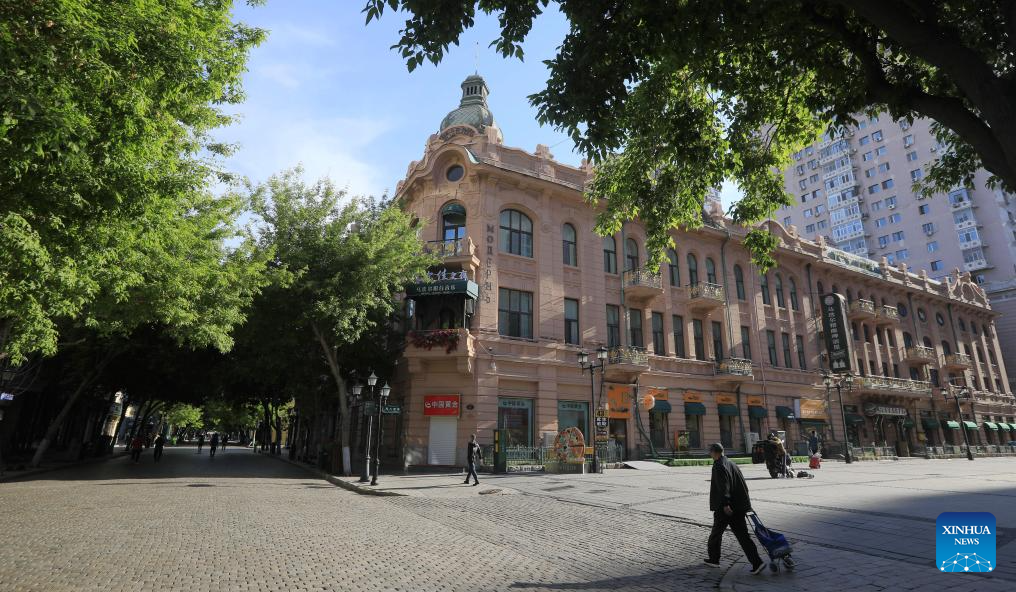
This photo taken on June 11, 2025 shows the Modern Hotel at the Central Street in Harbin, northeast China's Heilongjiang Province.
Harbin is often described by its residents as a city that emerged in tandem with the railway. Iconic buildings such as the St. Sophia Cathedral stand as evidence of European migration, trade and culture that dated back to the late 19th and early 20th centuries after the construction of the Chinese Eastern Railway in 1898. Records show Harbin was once home to people from over 30 countries.
The city, with over 9 million residents, now boasts 16 different architectural styles -- Byzantine, neo-classical, art deco, baroque -- and its number of historical buildings accounts for over 1,000.
Harbin, like many Chinese metropolises, has seen significant cultural development in recent years, which reflects the city's growth and increasing global outreach. Such development has further shaped the city's identity and enriched the lives of residents. (Photo by Zhang Shu/Xinhua)
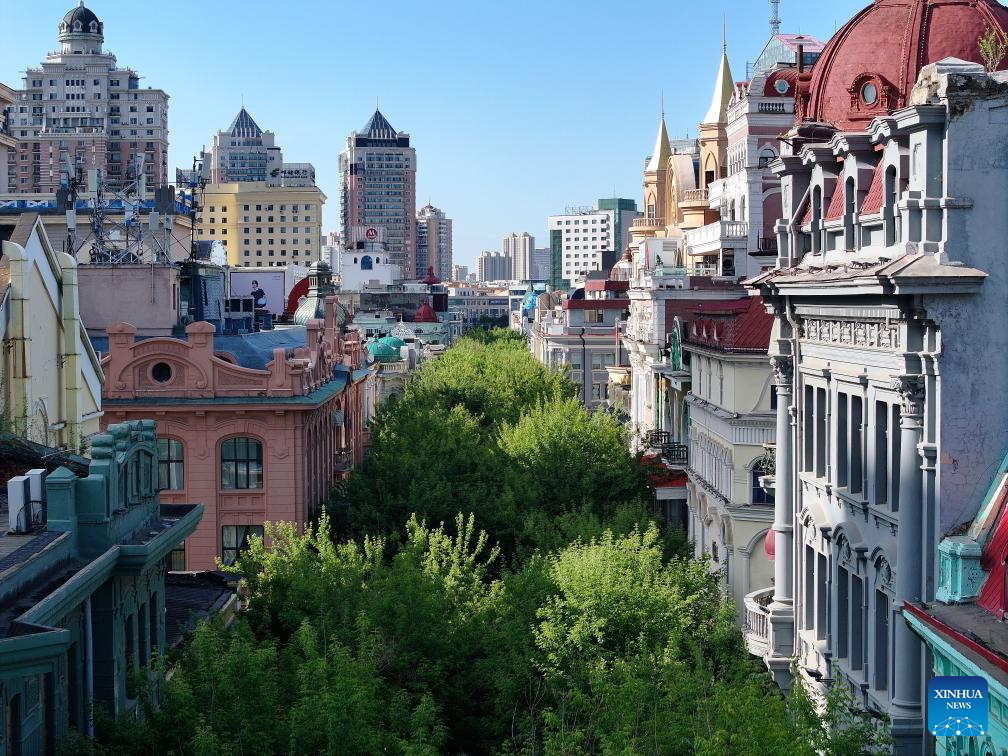
An aerial drone photo taken on June 11, 2025 shows a view of the Central Street in Harbin, northeast China's Heilongjiang Province.
Harbin is often described by its residents as a city that emerged in tandem with the railway. Iconic buildings such as the St. Sophia Cathedral stand as evidence of European migration, trade and culture that dated back to the late 19th and early 20th centuries after the construction of the Chinese Eastern Railway in 1898. Records show Harbin was once home to people from over 30 countries.
The city, with over 9 million residents, now boasts 16 different architectural styles -- Byzantine, neo-classical, art deco, baroque -- and its number of historical buildings accounts for over 1,000.
Harbin, like many Chinese metropolises, has seen significant cultural development in recent years, which reflects the city's growth and increasing global outreach. Such development has further shaped the city's identity and enriched the lives of residents. (Photo by Zhang Shu/Xinhua)
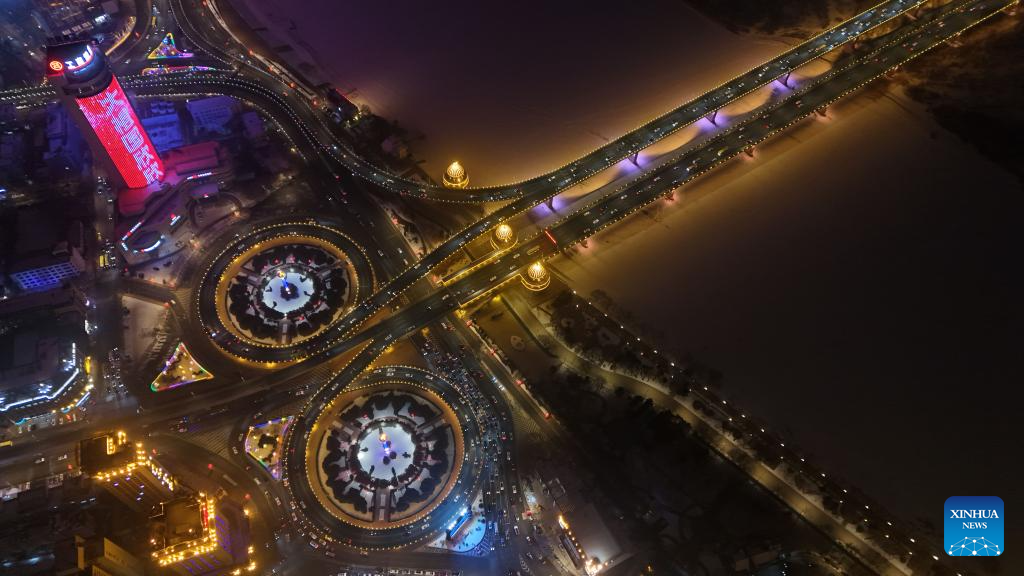
An aerial drone photo taken on Jan. 26, 2025 shows a night view of a Songhua River bridge in Harbin, northeast China's Heilongjiang Province.
Harbin is often described by its residents as a city that emerged in tandem with the railway. Iconic buildings such as the St. Sophia Cathedral stand as evidence of European migration, trade and culture that dated back to the late 19th and early 20th centuries after the construction of the Chinese Eastern Railway in 1898. Records show Harbin was once home to people from over 30 countries.
The city, with over 9 million residents, now boasts 16 different architectural styles -- Byzantine, neo-classical, art deco, baroque -- and its number of historical buildings accounts for over 1,000.
Harbin, like many Chinese metropolises, has seen significant cultural development in recent years, which reflects the city's growth and increasing global outreach. Such development has further shaped the city's identity and enriched the lives of residents. (Xinhua/Wang Song)
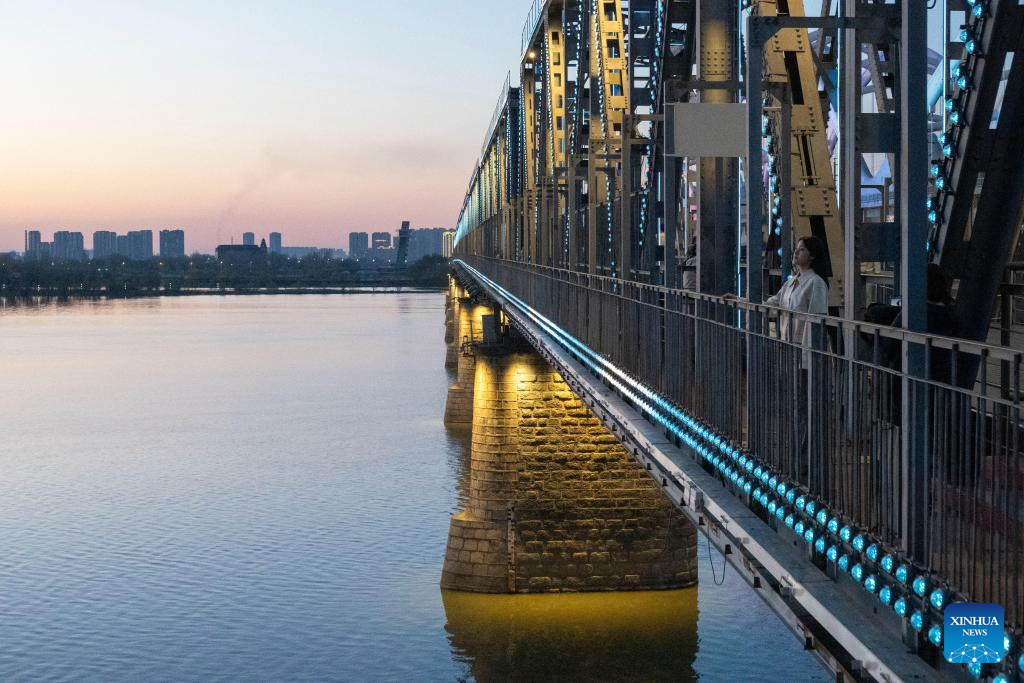
People have fun at a pedestrian zone that used to be a railway bridge in Harbin, capital of northeast China's Heilongjiang Province, April 22, 2025.
Harbin is often described by its residents as a city that emerged in tandem with the railway. Iconic buildings such as the St. Sophia Cathedral stand as evidence of European migration, trade and culture that dated back to the late 19th and early 20th centuries after the construction of the Chinese Eastern Railway in 1898. Records show Harbin was once home to people from over 30 countries.
The city, with over 9 million residents, now boasts 16 different architectural styles -- Byzantine, neo-classical, art deco, baroque -- and its number of historical buildings accounts for over 1,000.
Harbin, like many Chinese metropolises, has seen significant cultural development in recent years, which reflects the city's growth and increasing global outreach. Such development has further shaped the city's identity and enriched the lives of residents. (Xinhua/Xie Jianfei)
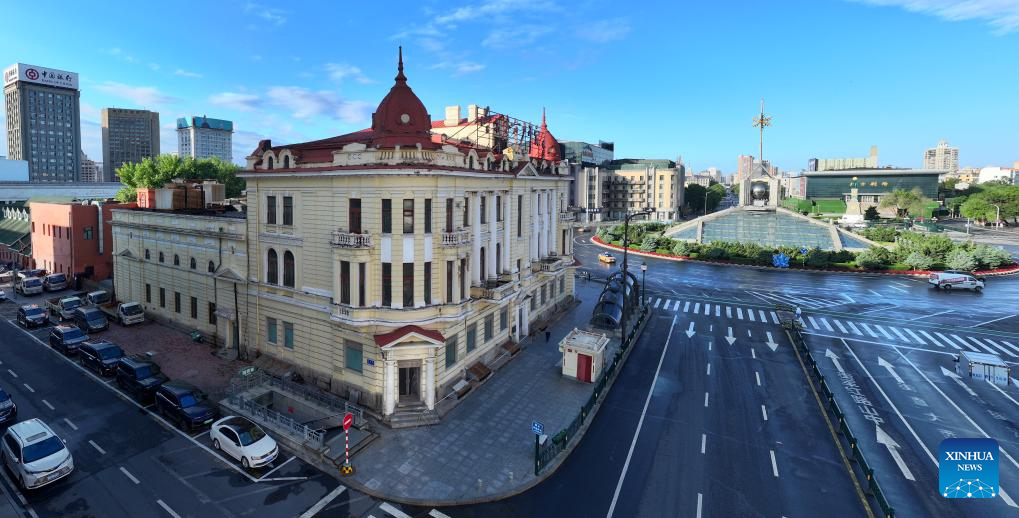
An aerial drone photo taken on June 11, 2025 shows a historical building in Harbin, northeast China's Heilongjiang Province.
Harbin is often described by its residents as a city that emerged in tandem with the railway. Iconic buildings such as the St. Sophia Cathedral stand as evidence of European migration, trade and culture that dated back to the late 19th and early 20th centuries after the construction of the Chinese Eastern Railway in 1898. Records show Harbin was once home to people from over 30 countries.
The city, with over 9 million residents, now boasts 16 different architectural styles -- Byzantine, neo-classical, art deco, baroque -- and its number of historical buildings accounts for over 1,000.
Harbin, like many Chinese metropolises, has seen significant cultural development in recent years, which reflects the city's growth and increasing global outreach. Such development has further shaped the city's identity and enriched the lives of residents. (Photo by Zhang Shu/Xinhua)
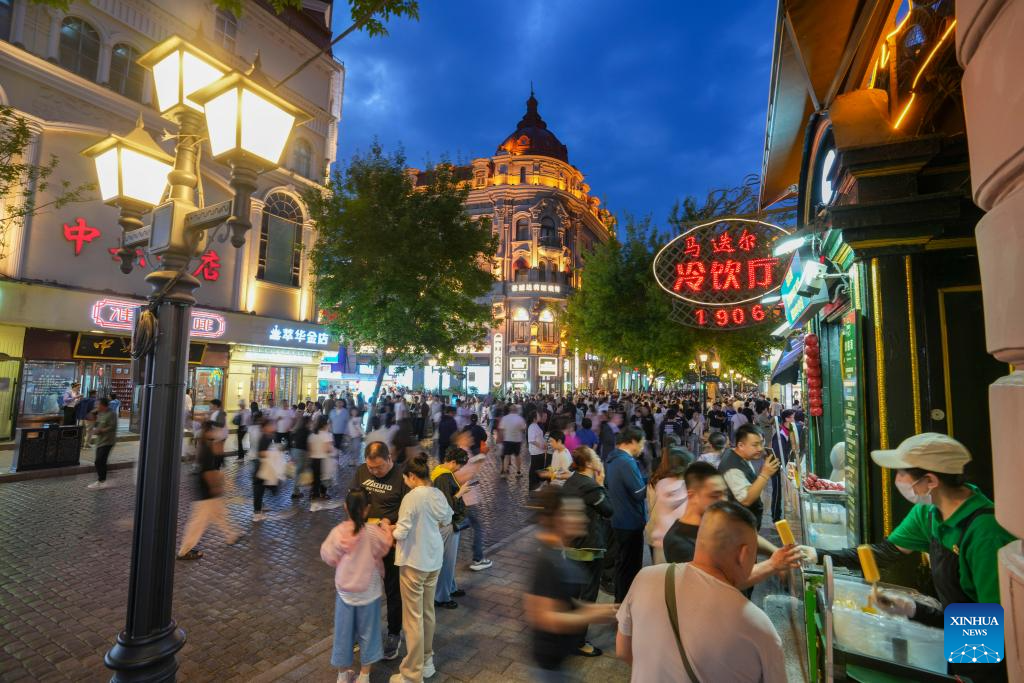
People visit the Central Street in Harbin, northeast China's Heilongjiang Province, June 8, 2025.
Harbin is often described by its residents as a city that emerged in tandem with the railway. Iconic buildings such as the St. Sophia Cathedral stand as evidence of European migration, trade and culture that dated back to the late 19th and early 20th centuries after the construction of the Chinese Eastern Railway in 1898. Records show Harbin was once home to people from over 30 countries.
The city, with over 9 million residents, now boasts 16 different architectural styles -- Byzantine, neo-classical, art deco, baroque -- and its number of historical buildings accounts for over 1,000.
Harbin, like many Chinese metropolises, has seen significant cultural development in recent years, which reflects the city's growth and increasing global outreach. Such development has further shaped the city's identity and enriched the lives of residents. (Xinhua/Wang Jianwei)
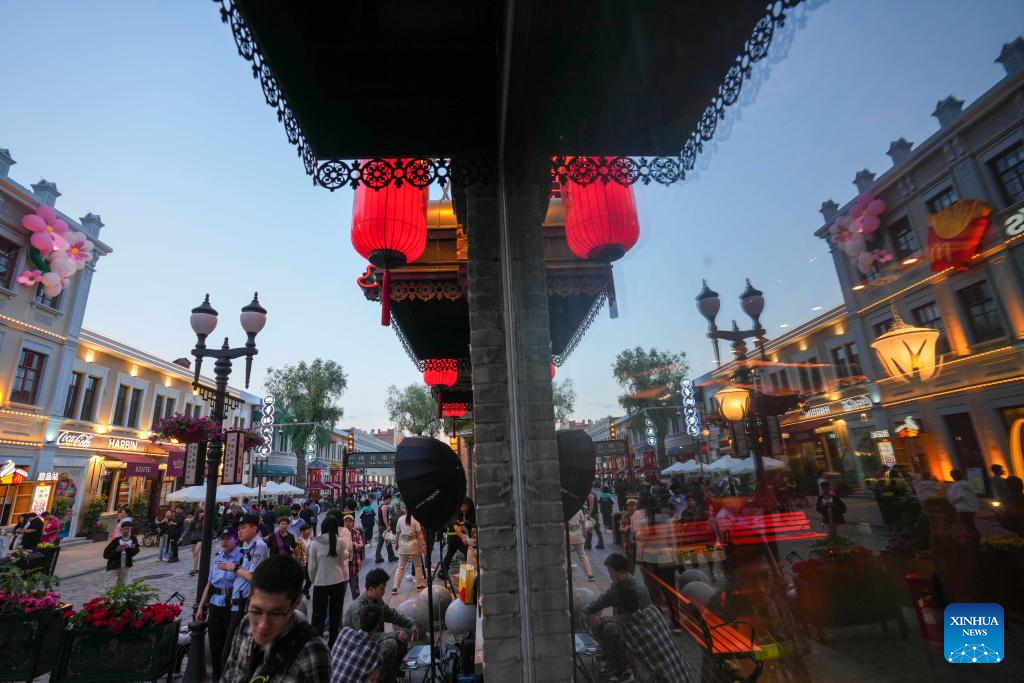
People visit a historical and cultural district in Harbin, northeast China's Heilongjiang Province, June 7, 2025.
Harbin is often described by its residents as a city that emerged in tandem with the railway. Iconic buildings such as the St. Sophia Cathedral stand as evidence of European migration, trade and culture that dated back to the late 19th and early 20th centuries after the construction of the Chinese Eastern Railway in 1898. Records show Harbin was once home to people from over 30 countries.
The city, with over 9 million residents, now boasts 16 different architectural styles -- Byzantine, neo-classical, art deco, baroque -- and its number of historical buildings accounts for over 1,000.
Harbin, like many Chinese metropolises, has seen significant cultural development in recent years, which reflects the city's growth and increasing global outreach. Such development has further shaped the city's identity and enriched the lives of residents. (Xinhua/Wang Jianwei)
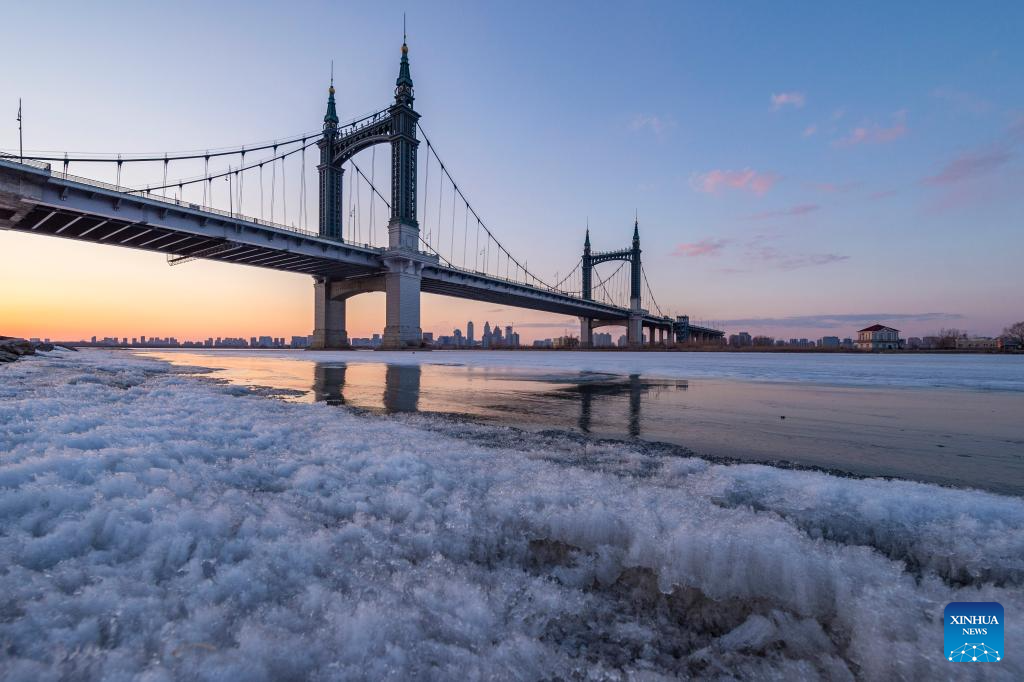
This photo taken on March 31, 2022 shows a view of Yangmingtan Bridge in Harbin, capital of northeast China's Heilongjiang Province.
Harbin is often described by its residents as a city that emerged in tandem with the railway. Iconic buildings such as the St. Sophia Cathedral stand as evidence of European migration, trade and culture that dated back to the late 19th and early 20th centuries after the construction of the Chinese Eastern Railway in 1898. Records show Harbin was once home to people from over 30 countries.
The city, with over 9 million residents, now boasts 16 different architectural styles -- Byzantine, neo-classical, art deco, baroque -- and its number of historical buildings accounts for over 1,000.
Harbin, like many Chinese metropolises, has seen significant cultural development in recent years, which reflects the city's growth and increasing global outreach. Such development has further shaped the city's identity and enriched the lives of residents. (Xinhua/Xie Jianfei)
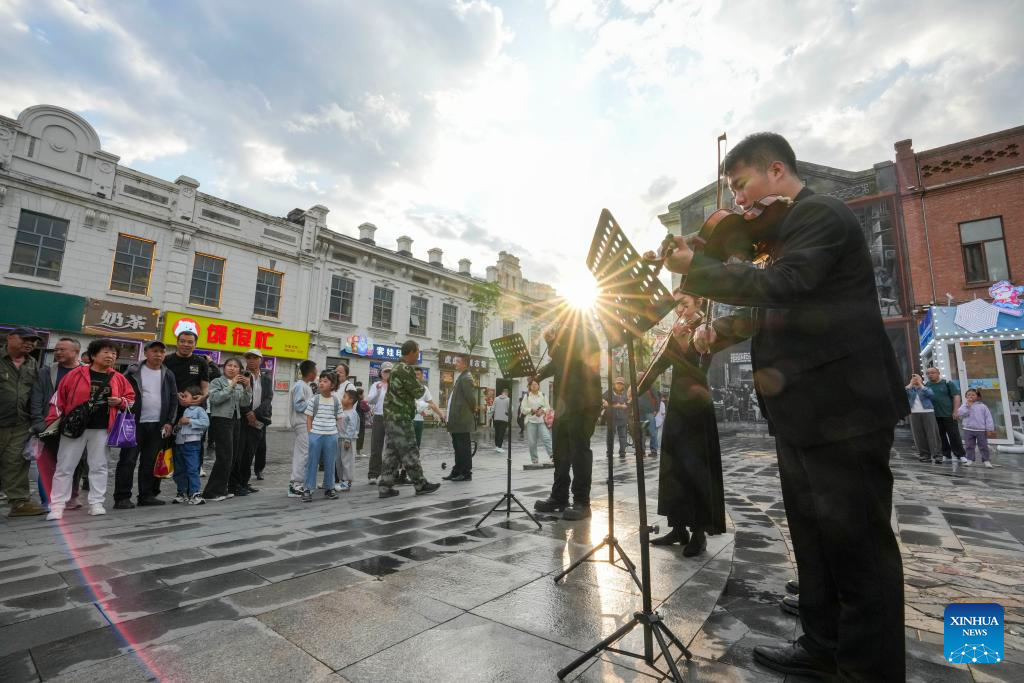
People watch a performance at a historical and cultural district in Harbin, northeast China's Heilongjiang Province, June 7, 2025. Harbin is often described by its residents as a city that emerged in tandem with the railway. Iconic buildings such as the St. Sophia Cathedral stand as evidence of European migration, trade and culture that dated back to the late 19th and early 20th centuries after the construction of the Chinese Eastern Railway in 1898. Records show Harbin was once home to people from over 30 countries.
The city, with over 9 million residents, now boasts 16 different architectural styles -- Byzantine, neo-classical, art deco, baroque -- and its number of historical buildings accounts for over 1,000.
Harbin, like many Chinese metropolises, has seen significant cultural development in recent years, which reflects the city's growth and increasing global outreach. Such development has further shaped the city's identity and enriched the lives of residents. (Xinhua/Wang Jianwei)
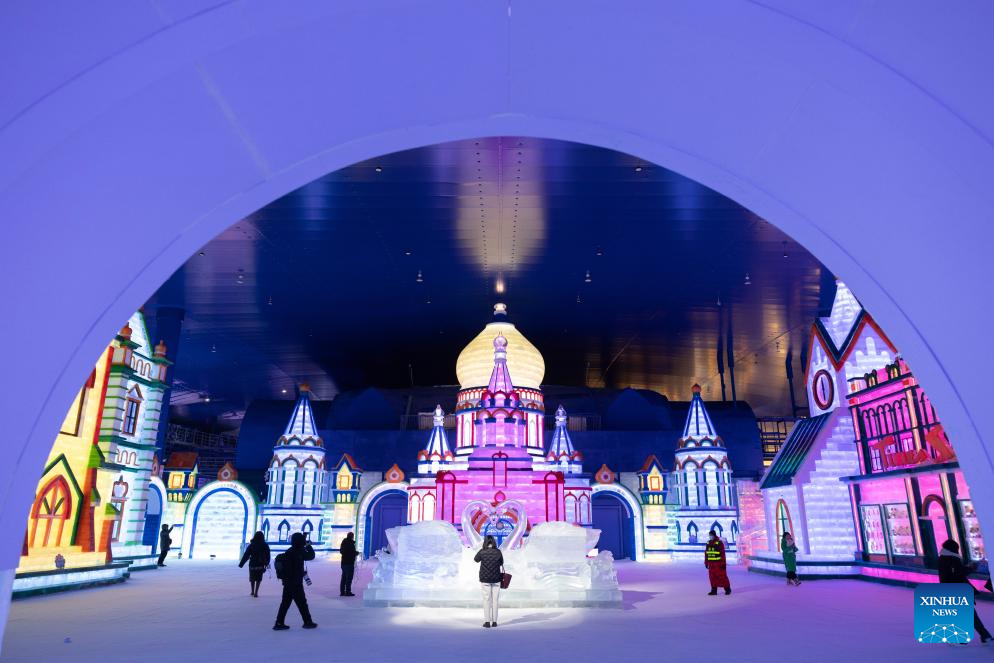
Tourists have fun at an indoor ice-and-snow theme park within Harbin Ice-Snow World in Harbin, northeast China's Heilongjiang Province, Feb. 27, 2025.
Harbin is often described by its residents as a city that emerged in tandem with the railway. Iconic buildings such as the St. Sophia Cathedral stand as evidence of European migration, trade and culture that dated back to the late 19th and early 20th centuries after the construction of the Chinese Eastern Railway in 1898. Records show Harbin was once home to people from over 30 countries.
The city, with over 9 million residents, now boasts 16 different architectural styles -- Byzantine, neo-classical, art deco, baroque -- and its number of historical buildings accounts for over 1,000.
Harbin, like many Chinese metropolises, has seen significant cultural development in recent years, which reflects the city's growth and increasing global outreach. Such development has further shaped the city's identity and enriched the lives of residents. (Xinhua/Zhang Tao)
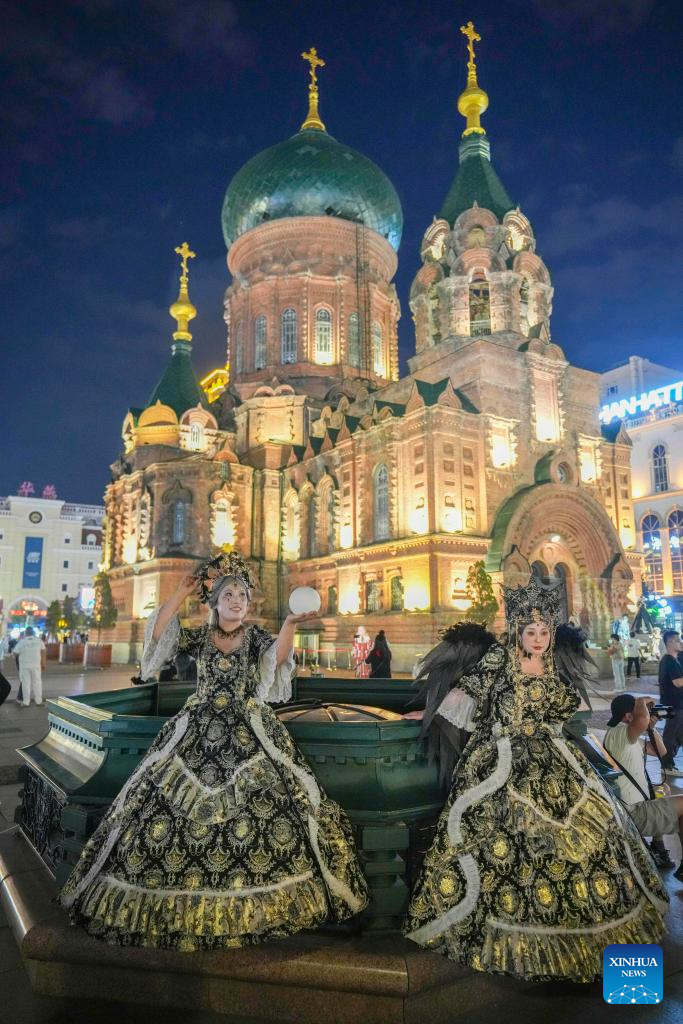
People in costumes pose for photos at the Central Street in Harbin, northeast China's Heilongjiang Province, June 8, 2025.
Harbin is often described by its residents as a city that emerged in tandem with the railway. Iconic buildings such as the St. Sophia Cathedral stand as evidence of European migration, trade and culture that dated back to the late 19th and early 20th centuries after the construction of the Chinese Eastern Railway in 1898. Records show Harbin was once home to people from over 30 countries.
The city, with over 9 million residents, now boasts 16 different architectural styles -- Byzantine, neo-classical, art deco, baroque -- and its number of historical buildings accounts for over 1,000.
Harbin, like many Chinese metropolises, has seen significant cultural development in recent years, which reflects the city's growth and increasing global outreach. Such development has further shaped the city's identity and enriched the lives of residents. (Xinhua/Wang Jianwei)
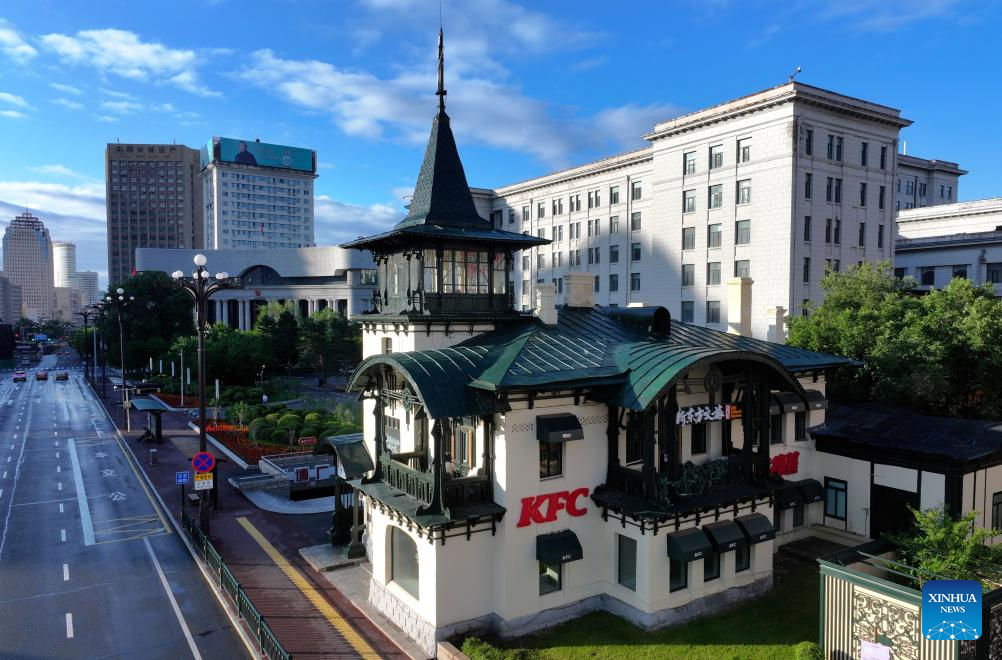
An aerial drone photo taken on June 11, 2025 shows a historical building in Harbin, northeast China's Heilongjiang Province.
Harbin is often described by its residents as a city that emerged in tandem with the railway. Iconic buildings such as the St. Sophia Cathedral stand as evidence of European migration, trade and culture that dated back to the late 19th and early 20th centuries after the construction of the Chinese Eastern Railway in 1898. Records show Harbin was once home to people from over 30 countries.
The city, with over 9 million residents, now boasts 16 different architectural styles -- Byzantine, neo-classical, art deco, baroque -- and its number of historical buildings accounts for over 1,000.
Harbin, like many Chinese metropolises, has seen significant cultural development in recent years, which reflects the city's growth and increasing global outreach. Such development has further shaped the city's identity and enriched the lives of residents. (Photo by Zhang Shu/Xinhua)
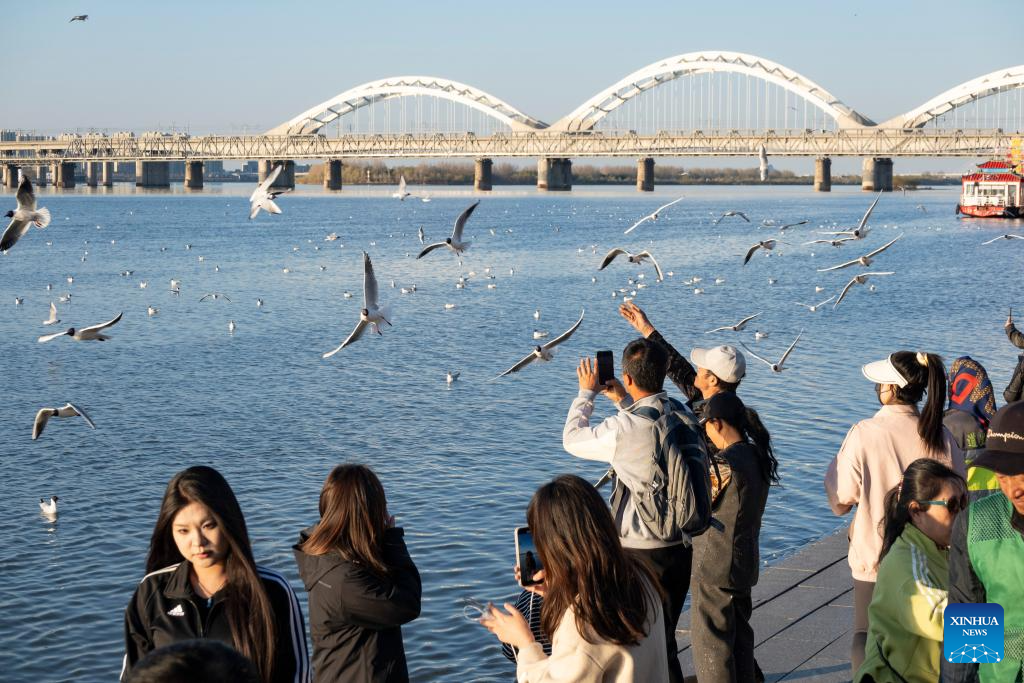
People have fun by the Songhua River in Harbin, northeast China's Heilongjiang Province, April 22, 2025.
Harbin is often described by its residents as a city that emerged in tandem with the railway. Iconic buildings such as the St. Sophia Cathedral stand as evidence of European migration, trade and culture that dated back to the late 19th and early 20th centuries after the construction of the Chinese Eastern Railway in 1898. Records show Harbin was once home to people from over 30 countries.
The city, with over 9 million residents, now boasts 16 different architectural styles -- Byzantine, neo-classical, art deco, baroque -- and its number of historical buildings accounts for over 1,000.
Harbin, like many Chinese metropolises, has seen significant cultural development in recent years, which reflects the city's growth and increasing global outreach. Such development has further shaped the city's identity and enriched the lives of residents. (Xinhua/Xie Jianfei)
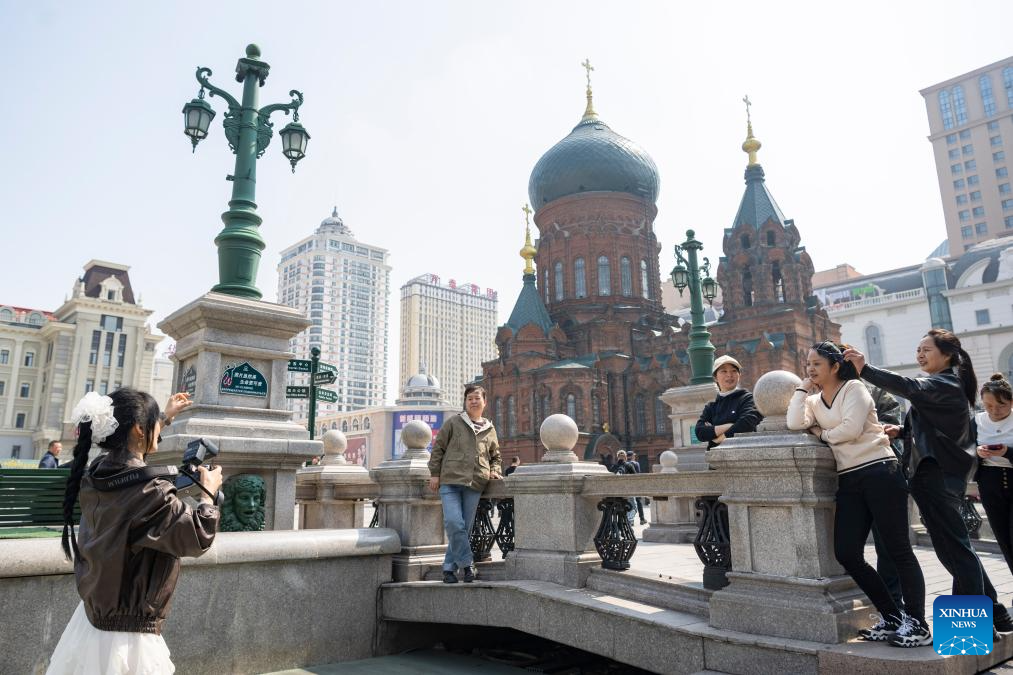
People take photos near the St. Sophia Cathedral in Harbin, capital of northeast China's Heilongjiang Province, April 8, 2025.
Harbin is often described by its residents as a city that emerged in tandem with the railway. Iconic buildings such as the St. Sophia Cathedral stand as evidence of European migration, trade and culture that dated back to the late 19th and early 20th centuries after the construction of the Chinese Eastern Railway in 1898. Records show Harbin was once home to people from over 30 countries.
The city, with over 9 million residents, now boasts 16 different architectural styles -- Byzantine, neo-classical, art deco, baroque -- and its number of historical buildings accounts for over 1,000.
Harbin, like many Chinese metropolises, has seen significant cultural development in recent years, which reflects the city's growth and increasing global outreach. Such development has further shaped the city's identity and enriched the lives of residents. (Xinhua/Xie Jianfei)
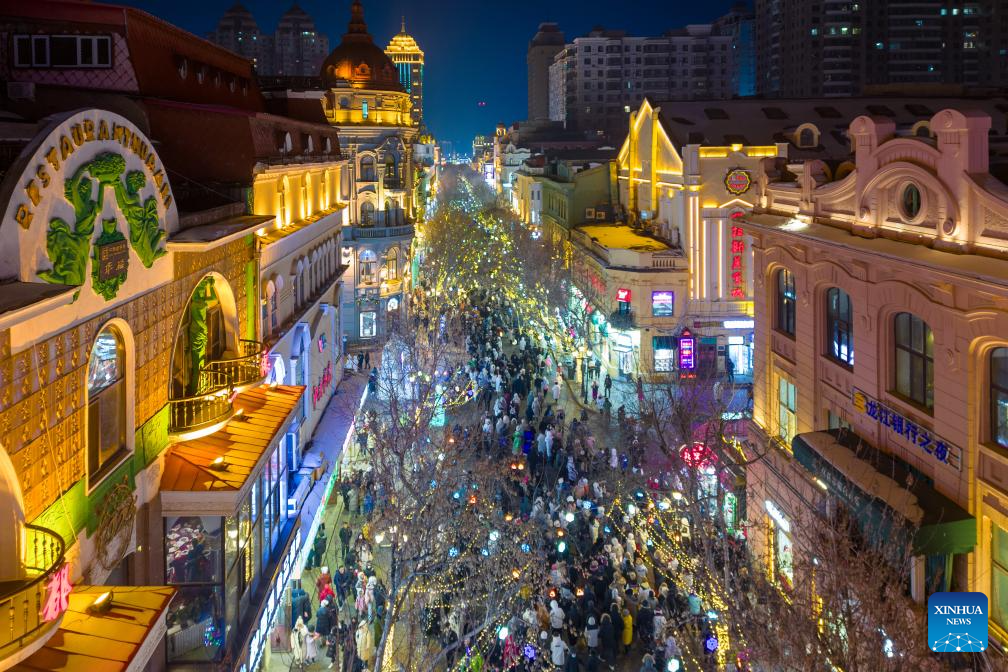
An aerial drone photo taken on Jan. 9, 2024 shows people visiting the Central Street in Harbin, northeast China's Heilongjiang Province.
Harbin is often described by its residents as a city that emerged in tandem with the railway. Iconic buildings such as the St. Sophia Cathedral stand as evidence of European migration, trade and culture that dated back to the late 19th and early 20th centuries after the construction of the Chinese Eastern Railway in 1898. Records show Harbin was once home to people from over 30 countries.
The city, with over 9 million residents, now boasts 16 different architectural styles -- Byzantine, neo-classical, art deco, baroque -- and its number of historical buildings accounts for over 1,000.
Harbin, like many Chinese metropolises, has seen significant cultural development in recent years, which reflects the city's growth and increasing global outreach. Such development has further shaped the city's identity and enriched the lives of residents. (Xinhua/Zhang Tao)
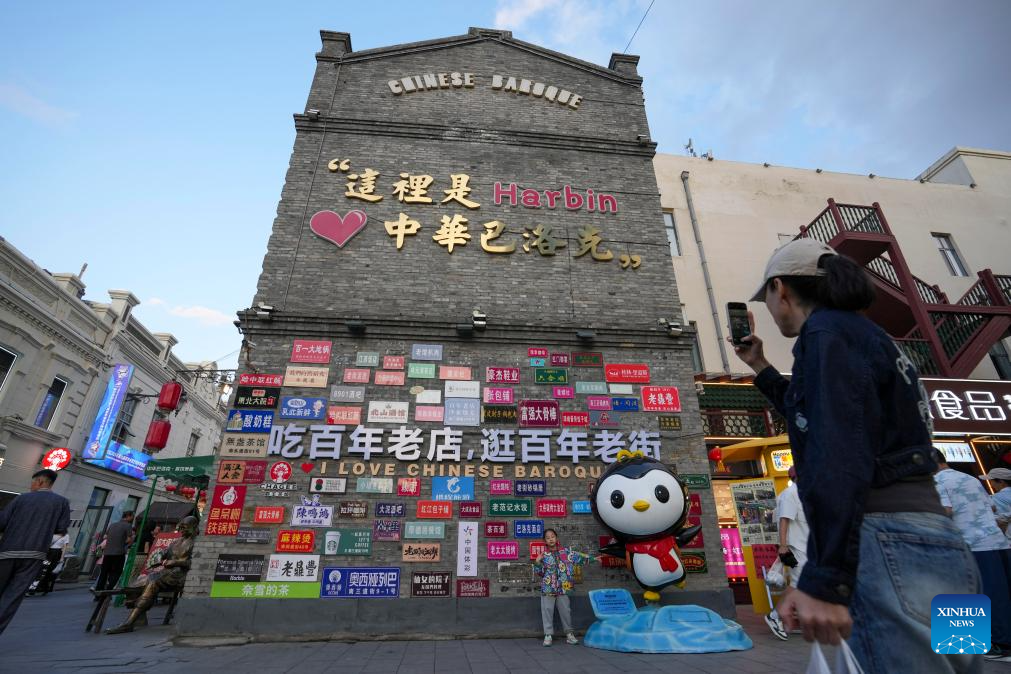
People visit a historical and cultural district in Harbin, northeast China's Heilongjiang Province, June 7, 2025.
Harbin is often described by its residents as a city that emerged in tandem with the railway. Iconic buildings such as the St. Sophia Cathedral stand as evidence of European migration, trade and culture that dated back to the late 19th and early 20th centuries after the construction of the Chinese Eastern Railway in 1898. Records show Harbin was once home to people from over 30 countries.
The city, with over 9 million residents, now boasts 16 different architectural styles -- Byzantine, neo-classical, art deco, baroque -- and its number of historical buildings accounts for over 1,000.
Harbin, like many Chinese metropolises, has seen significant cultural development in recent years, which reflects the city's growth and increasing global outreach. Such development has further shaped the city's identity and enriched the lives of residents. (Xinhua/Wang Jianwei)
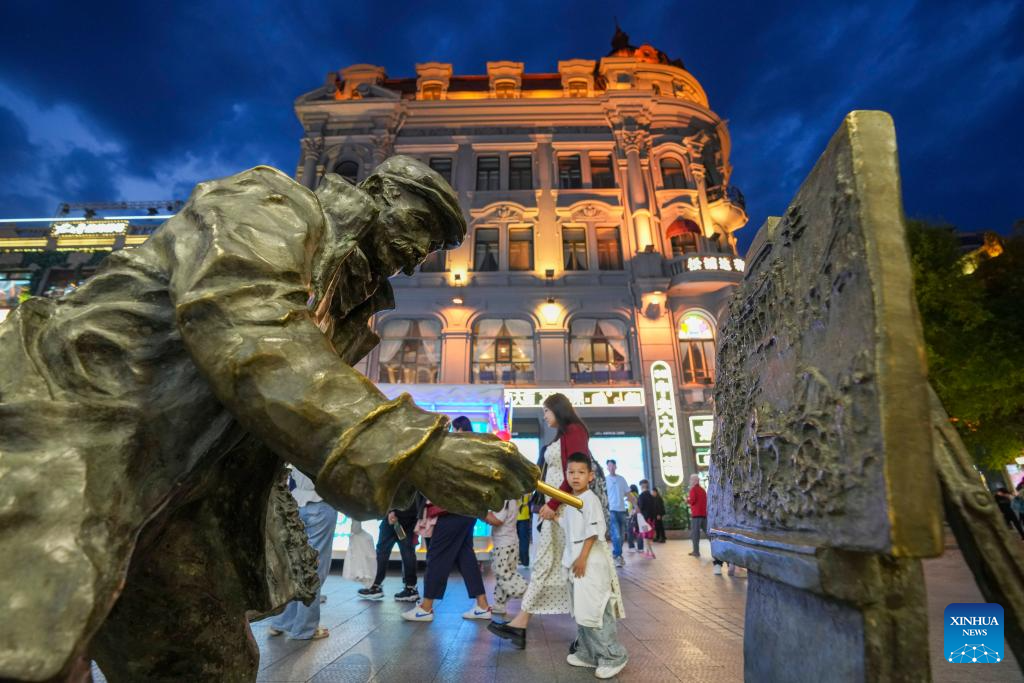
People visit the Central Street in Harbin, northeast China's Heilongjiang Province, June 8, 2025.
Harbin is often described by its residents as a city that emerged in tandem with the railway. Iconic buildings such as the St. Sophia Cathedral stand as evidence of European migration, trade and culture that dated back to the late 19th and early 20th centuries after the construction of the Chinese Eastern Railway in 1898. Records show Harbin was once home to people from over 30 countries.
The city, with over 9 million residents, now boasts 16 different architectural styles -- Byzantine, neo-classical, art deco, baroque -- and its number of historical buildings accounts for over 1,000.
Harbin, like many Chinese metropolises, has seen significant cultural development in recent years, which reflects the city's growth and increasing global outreach. Such development has further shaped the city's identity and enriched the lives of residents. (Xinhua/Wang Jianwei)



